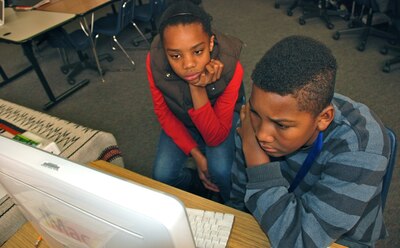Charter school leader James Cryan and advocate Myles Mendoza say education may finally be moving into the digital age with the growing blended learning movement.
Education in Colorado is getting ready to experience a dramatic revolution. In 10 years, every teacher will use technology tools to help deliver, assess and guide instruction. This week, Sal Khan of the Khan Academy is speaking at the University of Denver. Next week, a large educational-technology start-up weekend is happening in Boulder. Schools like Rocky Mountain Prep, the Odyssey School, Denver School of Science and Technology and Grant Middle School are incubating new models of education.
Teaching is one of the few professions that has not experienced a significant transformation since the 1800s. This differs dramatically from almost all other professions, which have largely capitalized on productivity gains from technology and specialization.

Hospitals have advanced medical equipment, integral to the evaluation, treatment and monitoring of patients. Police are equipped with advanced technology, providing officers the ability to access databases, view maps, issue amber alerts, collect and transfer witness statements, and much more.
Even the oft-maligned Post Office has a technological backbone which makes its services both efficient and amazingly reliable. In our own lives, most of us can’t last more than 4 hours without emailing or using a smartphone. Technology has become an integral part of nearly every society, with one glaring exception – education.
Most classrooms have yet to experience the transformative impact of technology. The Harvard Business Review recently reported that the education sector ranks last in effective use of technology.
In real time, this means teachers are asked to wear many hats: Data analyst, lunchroom monitor, phonics interventionist, customer service specialist and counselor.
However, there is a new “blended learning” (a combination of teacher-led and computer-learning) education movement taking place that holds an implicit belief that teacher’s specialized skills should be better appreciated and used in a more precise manner. A blended model couples digital/online learning with in-person instruction in a traditional school setting. Capitalizing on the irreplaceable role of the teacher, and the capacity of technology to individualize, teach and track student learning around core concepts, a blended model is education innovation at its best. The teacher’s role moves from primarily remediation and skill building to knowledge application, extension and debate. Student-teacher interaction is increasingly targeted and small-group based, offering more individualized instruction.
What teacher wouldn’t love that?
None of these ideas would be worth pursuing if they didn’t lead to a more effective education for students. As the Harvard Business Review reported last month in the article “Rethinking Education,” the results are promising. Rocketship Education, a group of seven blended-learning schools, are the top-performing schools in their district of San Jose and their largely low-income students perform at the same level as the affluent Palo Alto school district. In New York City, the personalized, tech-heavy math learning program called School of One, students learned 60 percent more than their traditionally taught peers. Even more exciting is the potential blended learning is bringing to rural communities. In rural Arizona, the Carpe Diem School has ranked top in its county and in the top 10 percent of charters in Arizona. Taking advantage of great free programs, such as the Khan Academy, a group of 2,700 short online videos, these schools are able to make the teachers’ job more focused and more effective.
The need to improve education in Colorado is clear. Here in Denver approximately five out of 10 students don’t graduate from high-school and only one out of 10 will graduate from college. Now is the time to embrace bringing these ideas to bear here in Colorado. Hockey great Wayne Gretzky once said, “I skate to where the puck is going to be, not where it has been.” However, innovation has rarely come from the state, policy makers or school districts. Rather, It’s up to them to encourage innovative teachers and schools to rethink technology tools and get out of the way. We all need to skate in that direction.
Imagine removing technology from hospitals, law enforcement agencies, or our daily lives – quite unsettling, right? We must think of our schools in similar terms. Teaching and learning is limited by the absence of innovative technology in our schools. With such a broad base of blended learning proponents and recent innovations in education, the time to bring technology into our schools is now.
About our First Person series:
First Person is where Chalkbeat features personal essays by educators, students, parents, and others trying to improve public education. Read our submission guidelines here.
